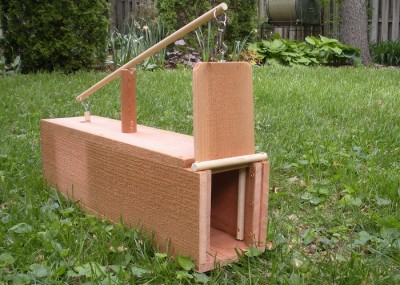 My Dad grew up in a very lean household. Although the Great Depression had passed by the time he came along, for a variety of reasons it never quite ended in his home. As a result of the family’s economic circumstances, a lot of their protein intake was dependent on the older boys keeping rabbits, squirrels and even the occasional opossum or raccoon in the cook pot.
My Dad grew up in a very lean household. Although the Great Depression had passed by the time he came along, for a variety of reasons it never quite ended in his home. As a result of the family’s economic circumstances, a lot of their protein intake was dependent on the older boys keeping rabbits, squirrels and even the occasional opossum or raccoon in the cook pot.
Many fall and winter mornings began with each of the boys being sent out, before school, with a lone shotgun shell and a mandate to return with meat for the evening meal. As a young boy hearing these stories, I conjured up images of ancient Spartans, cautioned to return from battle with their shield or on it. I’m sure it wasn’t quite as extreme as all that, but for a kid growing up in a home where food was plentiful and hunting was sport, these tales of scarcity and necessity were about as foreign to me as Greek mythology.
One of the cheats that my Dad and his brothers used to extend their supply of shotgun shells was the small game box trap. If a rabbit could be gotten in this method, and another with the gun, it was a “twofer,” and the evening meal was that much more.
In principle, box traps are as simple as they sound; they are a wooden box with a sliding door at one end and a trigger mechanism that holds the door open until tripped and allows it to fall when a critter enters the box and bumps it. The trigger is the hardest part to perfect, and caused us some trouble this season. The box can be built out of just about any wood you choose. We used 1×10 pine planks for the box and door, although plywood would do just as well.
What you’ll need
I like to start every project with a cutting list, so here it is:
From your 1×10 (or approximate equivalent):
- 3 28-inch boards
- 1 24-inch board
- 1 11-inch door, ripped to fit (about 8 inches wide)
Also:
- 4 runners, as long as your planks are wide (9.5 inches in our case)
- 2 12-inch uprights for your handle/pivot
- 1 11-inch handle/pivot (or the width of your box, dependent on the lumber used)
- 1 inch piece to carve into a trigger
- 1 24-inch trigger rocker arm
In addition, you will need a piece of half inch hardware cloth the size of the back of your box, and a few feet of paracord or other cordage. And some nails or screws for assembling the pieces (Dad chose 1.5 inch wood screws, and predrilled the holes).
Getting started
Once you have your pieces cut, Step 1 is to assemble your box. The longer boards will be the bottom and sides, the shorter one will be the top. If you use screws, it would be wise to pre-drill your screw holes. Add your hardware cloth to the back, and drill a one-inch hole in the center of the top about six inches in from the back edge.
The ultimate how-to handbook for all generations!
Step 2 is to add your door runners. One is mounted to each side, wall flush and plumb to the leading edge of the box’s top. A second set is mounted, one to each side, just slightly more than the width of the door forward from the first set. The idea is to form a track that the door can slide up and down in.
Step 3 is to add the handle/trigger arm pivot. Attach the two uprights, one on either side of the box at the mid-point so that the top is eight inches above the top of the box. Mount the handle/pivot between these uprights, flush to the top.
Step 4 is to assemble your trigger mechanism and attach it to the door. Put a wood screw or eye screw in the center top of the door to attach your cordage. Drill a hole in each end of your rocker arm for the same purpose. Your trigger piece will have to be carved. You will have to whittle it down so that there is a notch in the middle deep enough to hold the trap door in place but shallow enough to be knocked off easily by a critter inside the box. The trigger piece is attached to one end of the rocker arm by cord, and the door to the other.
To set the trap, put some apple slices in the back. Put the door in its track. The rocker arm rests on the handle, and the trigger piece is put through the hole in the top of the box so that the notch engages the front of the hole. When everything is right, the door will be at the top of its track with its weight being held by the trigger piece. When your rabbit goes for the apple, it will knock the trigger piece free and the door will drop shut. Rabbit in a box! Triggers generally take some trial and error, and a bit of adjustment to get optimized.
Try to set your trap in areas where there is a lot of rabbit activity, on or along trails is optimum. When you find a trap has been tripped, look through the back before opening the front. My Dad says he learned this the hard way as a kid; skunks like apples as much as rabbits do! I like to use leather gloves when grabbing rabbits out of a trap, but my Dad goes bare handed. Once in hand, dispatch your rabbit quickly and humanely, I use a sharp blow to the base of the skull with a short length cut from an old shovel handle; Dad goes bare handed on this, as well.
We had a lot of issues this winter with the extreme cold. Triggers froze in place, doors froze in the up/open position, and ice made the traps tough to reset. As a result, our take wasn’t what it should have been. However, I still believe that the box trap can add important supplemental protein to your diet in a crisis, hard times, or anytime you want to eat rabbit. Trapping rabbits in this way conserves potentially valuable ammunition and is silent.
This is another one of those disappearing skills that we can pass on to our children or grandchildren, preserving our heritage and nourishing our souls while providing food to nourish our bodies.
Sign up for Off The Grid News’ weekly email and stay informed about the issues important to you
 Off The Grid News Better Ideas For Off The Grid Living
Off The Grid News Better Ideas For Off The Grid Living




